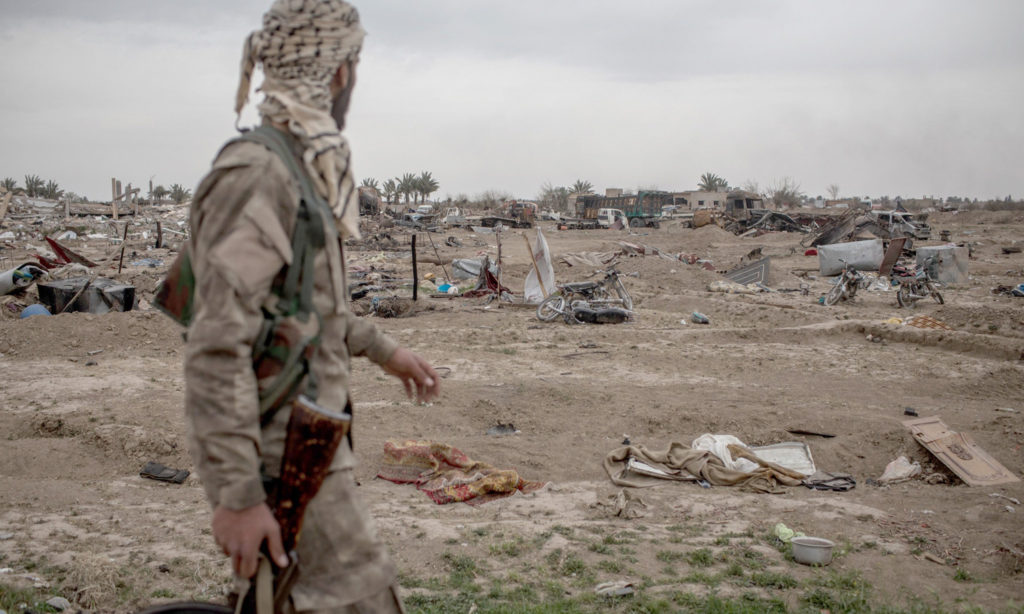Enab Baladi – Deir Ezzor
Twenty months have passed since the Syrian Democratic Forces (SDF) took control of al-Baghouz with the US-led international coalition’s help. The town grabbed headlines around the world over briefly in March 2019. Al-Baghouz has turned into the last stronghold of the Islamic State (IS) and is a refuge for tens of thousands of fighters and displaced persons who have endured some of the most brutal warfare.
After years of fighting IS, which drew the world’s attention, the IS’s self-proclaimed Caliphate’s lands have receded from large areas in Syria and Iraq. Their control is now limited to the small town in as-Souseh sub-district of al-Bukamal in the eastern countryside of Deir Ezzor.
Only the most loyal fighters of the IS group, including Syrians and foreigners, remained in al-Baghouz and decided to fight until their last breath. Some got their wish “to die for IS” before the departure of the convoys of displaced persons and prisoners who were scattered among dozens of camps and prisons in north-eastern Syria.
The bodies of 250 IS fighters and civilian victims whose fates were inextricably linked to the IS group were buried in a desert area near the town of al-Baghuz. The burials took place after the end of the ground battles conducted by the SDF with the support of the US-led international coalition’s airstrikes, a health worker in the eastern countryside of Deir Ezzor, who spoke on condition of anonymity, told Enab Baladi.
On 23 March 2019, the SDF announced the total territorial defeat of the IS group. However, that announcement was not sufficient to eliminate its last cells, which are still occasionally carrying out assassinations targeting institutional employees of the Kurdish-led Autonomous Administration of North and East of Syria (NES), civilians, and military personnel in the demolished town, which is dominated by fear.
Destruction remains
The town of al-Baghouz used to be mainly inhabited by tribes, namely al-Uqaydat, al-Marasama, and Jabour. But these groups have not been able yet to return to their homes. Although months have passed since the town was seized from IS control, the houses are still destroyed. The number of houses demolished after the end of the battles reached 700, according to statistics from-Baghouz residents at the time.
Talal al-Ashawi left his country house on the outskirts of al-Baghouz and fled to the city of Raqqa with his family during the battle; he was able to return home only two months after the battle’s end.
Al-Ashawi told Enab Baladi that when he came back home, his home was empty. He had nothing left.
Additionally, there were SDF checkpoints set up everywhere, and everybody was subject to search and strict scrutiny. Moreover, people were not allowed to go in and out of the city every day due to the heightened harassment and scrutiny by the SDF fighters; the fighters were on guard for any suspicious movement, al-Ashawi added.
Al-Ashawi, who is in his forties, felt “desperate” when he first saw his destroyed home. However, he pulled himself together, indicating that “life goes on,” and he needed to find some way to survive, as he put it.
Al-Ashawi and his family stayed in a relative’s house until they were able to build a mud house from simple, low-cost materials took refuge there with his five children and his wife.
Life in al-Baghouz
Today, most of the residents of al-Baghouz work in agriculture. Al-Baghouz is known for cultivating pomegranates and palm trees, in addition to raising livestock and producing milk and dairy products.
Rabih al-Nayef, a resident of the town, complains about the lack of support to reconstruct what was destroyed by the US-led coalition’s missiles after the town and its people entered a battle “that had no dog in the hunt,” as he put it.
Al-Nayef confirms that the people of al-Baghouz suffer from the lack of social services in the area— such as drinking water stations and bakeries— as well as bad roads, widespread building rubbles, and war remnants, the continued presence of mines, and deteriorating health conditions.
Al-Baghouz has only a small health clinic to serve the residents of the town. Al-Nayef also indicated that dead bodies and mass graves that have spread in the area have increased the prevalence of skin diseases among those who returned to the town. Moreover, relief organizations are not active and cannot support the people of al-Bahouz.
Signs of IS have not disappeared yet
In addition to the destruction, the effects of the IS’s control over al-Baghouz’s landmarks remained clear. The IS group’s slogans and banners, painted on the town’s buildings and homes, are still present.
The townspeople believe that their area is vulnerable to “marginalization,” like most of the areas in Deir Ezzor. Therefore, no rehabilitation or reconstruction of the essential physical and social infrastructure services are carried out.
However, a member of the SDF’s Deir Ezzor Civil Council, who spoke on condition of anonymity, points out that the marginalization of the town is not deliberate.
He highlighted that the majority of the NES employees in Deir Ezzor are locals.
The council member attributed the marginalization to the poor security situation and the instability prevailing in the region due to the active cells belonging to the Syrian regime and the Iranian militias that control areas near al-Baghouz, as well as the presence of IS-linked sleeper cells.
The SDF still faces several challenges to exercise its full sovereignty over the region. The SDF launches security campaigns from time to time to arrest wanted persons in the area with the international coalition’s help.
The only solution for the people of al-Baghouz is to accept the NES-associated institutions, the council member believes.
He warned that any discord between the ruling authority institutions with civilians will be in the Syrian regime and Iran’s interest. He estimated 15 percent of the destruction, which had affected 60 percent of al-Baghouz, was rebuilt. Of the 40,000 people who lived in the town before the battles, 20,000 have returned.

